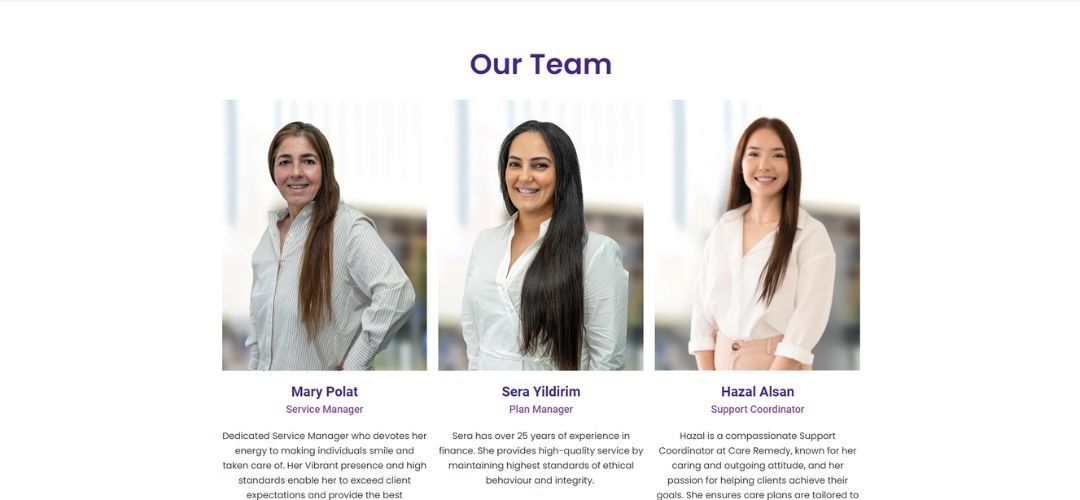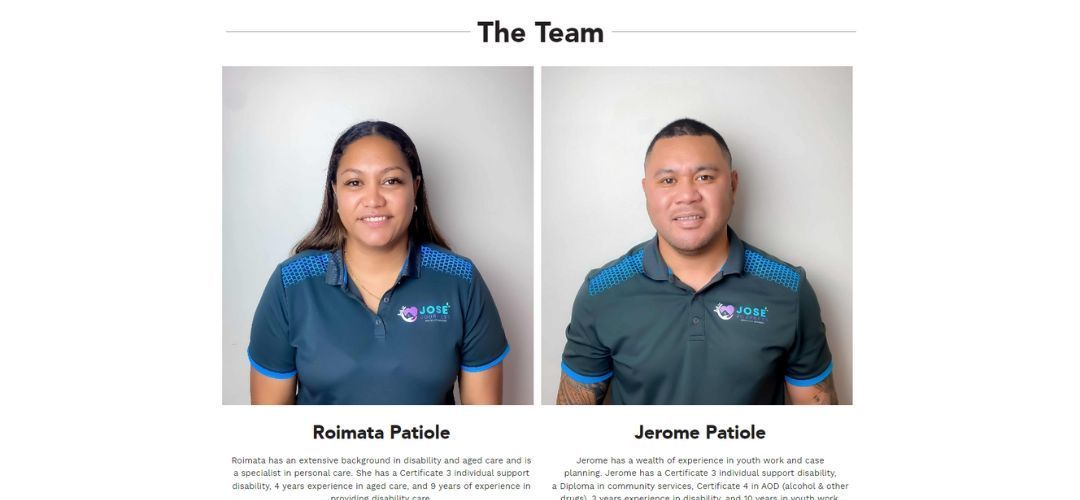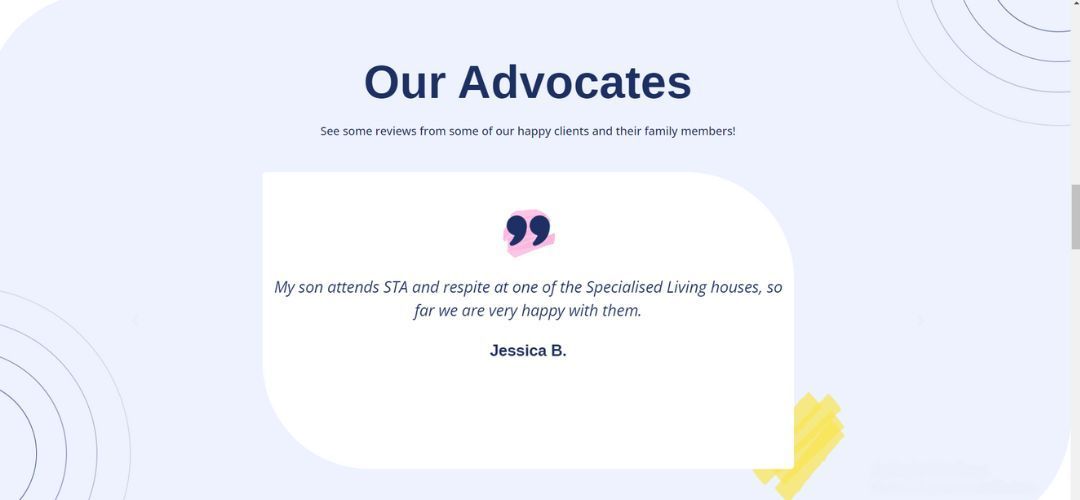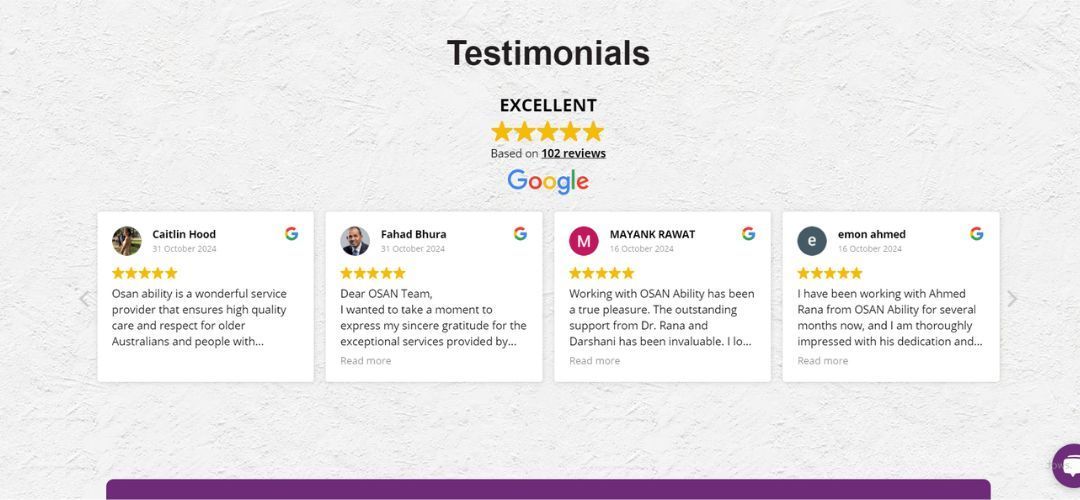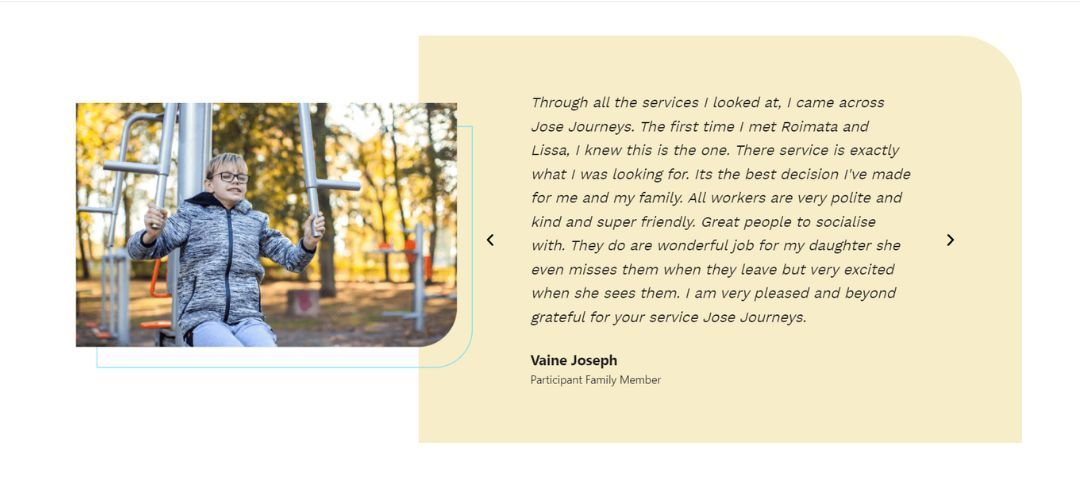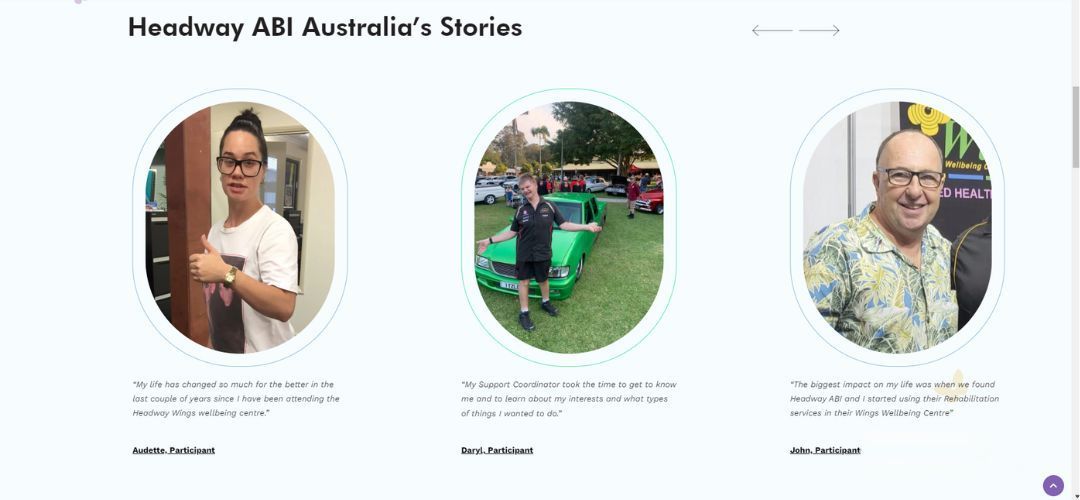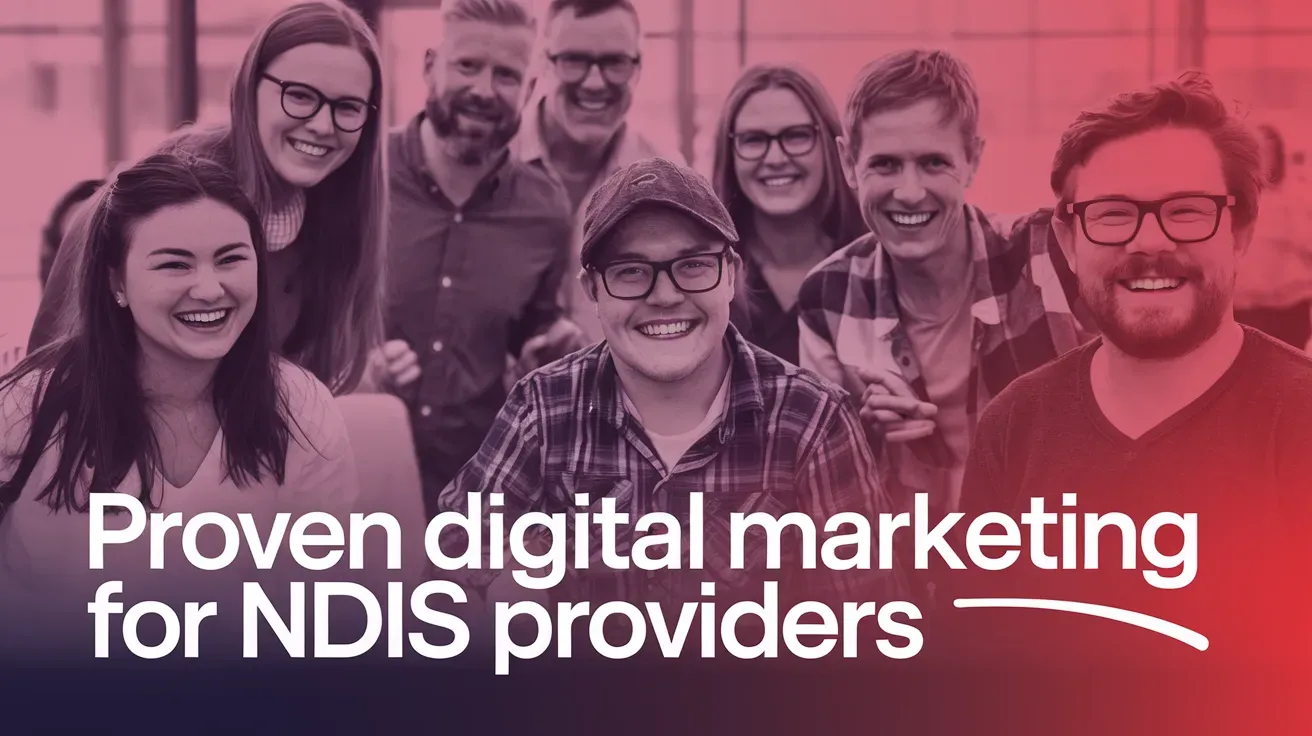Website Design for NDIS Service Provider
Designing a website for NDIS (National Disability Insurance Scheme) providers isn't just about making it visually appealing. It's an intricate process that involves understanding your audience, anticipating their needs, and crafting a seamless user experience.
To help you embark on this
digital journey, here are some key elements to consider:
Content is King: Provide clear, concise, and relevant information such as services you offer, how you onboard , participant stories, commonly asked questions, links to important government sites and how to contact etc.
It's crucial to break down information into digestible sections using subheadings and bullet points, making it easier to scan. Engage your audience by incorporating visuals such as images or videos that showcase participant stories or highlight your services in action. Additionally, using descriptive alt text helps ensure these elements are accessible to all users.
For
accessibility and functionality, employ a responsive design that adapts seamlessly to various screen sizes, ensuring a consistent experience across desktops, tablets, and smartphones. Implement keyboard navigation and screen reader optimisations to support diverse needs, recognising the wide spectrum of physical impairments your visitors may have.
Moving to
technical SEO and search visibility, ensure your website loads quickly and is free from broken links, enhancing both user experience and search engine rankings. Structure your content logically, with each page having clearly defined sections marked by heading tags (<h1>, <h2>, etc.), to improve crawlability by search engines. Every page should have a unique meta description and title tag that accurately reflects its content, enticing users to click through from search results.
Thoughtfully integrating these elements, your NDIS provider website can effectively communicate your message, foster trust, and stand out in search engine results, ensuring all visitors receive an inclusive and user-friendly experience.
What Content needs to be on an NDIS website
When crafting the content for an NDIS website, it's essential to offer comprehensive information that caters to the unique needs of both current and potential participants. Start by providing a clear overview of your services, ensuring that each service description is detailed yet concise. This not only helps to position your offerings but also allows visitors to easily assess how you can meet their needs.
Clear Messaging on Who You Serve: Clearly outline the types of clients and participants you support, ensuring they immediately feel understood and welcomed. As an NDIS provider, your target audience includes NDIS participants, their families, support coordinators, and other providers seeking additional assistance to meet participants’ specific needs.
Services for Specific Disabilities: Highlight the types of disabilities and support needs you cater to, so visitors know you offer the precise assistance they require. Whether you specialise in in-home care or excel in disability accommodation services such as Supported Independent Living (SIL), Specialist Disability Accommodation (SDA), or Respite care, ensure these offerings take prominence on your homepage and dedicate individual pages to provide further information.
Easy Enquiry Process: Explain how new participants and their families can reach out, including steps for initial consultations or assessments. It might only involve a straightforward three-step process.
Commitment to Quality Service:
Describe your approach and steps taken to ensure a high standard of care, reassuring clients about their experience with your organisation. As a business owner, it is essential to be empathetic when offering services, ensuring the privacy of all individuals involved. Clearly outline the processes for receiving feedback and complaints and detail how you plan to improve based on this input. Discuss your compliance processes and provide direct access for addressing concerns via phone or email. Highlight what additional services you can offer, and make sure this information is clearly stated on your website.
Mission and Values:
Share the core values that drive your work and your mission to provide impactful, compassionate support.
An NDIS provider's strength often lies in its mission and the values it upholds. Transparency, empathy, and a commitment to empowering individuals are crucial. By clearly articulating these values on your website, you effectively communicate your unique approach and dedication to service excellence.
Your mission statement should resonate with uplifting phrases highlighting the positive impact you aim to have in the community. Words such as "empowerment," "inclusivity," and "independence" are not just buzzwords, but the pillars of a truly supportive NDIS service. Convey how these principles guide every interaction, decision, and service you provide.
Remember, a strong connection stems from sharing your ethos. Participants and their families will appreciate understanding the motivation behind your services and how it aligns with their values and aspirations.
Meet the Team:
Introduce your team members, adding a personal touch with short bios to build trust and familiarity.
Sharing more about the individuals behind your NDIS services is a fantastic way to humanise your brand and foster connections with potential clients. Consider featuring each team member's role, experience, and what motivates them to work in this field. This not only highlights their qualifications but also shows their dedication to making a difference in the lives of those you serve. Include fun facts or hobbies to showcase their personalities, making them relatable and approachable.
To enhance this section, consider adding professional photographs. These images should capture your team in action, whether helping participants, interacting in a community event, or simply working together as a team. This adds a genuine and warm touch, visually reinforcing the written content. Such imagery not only builds trust but also allows visitors to see the real people who will support them, creating a sense of familiarity even before any direct interaction occurs.
Client Reviews:
Showcase testimonials and reviews to provide social proof and build confidence in your services.
Inviting clients to share their experiences can significantly boost your online presence. Not only do reviews and testimonials validate the quality of care you provide, but they also humanise your brand. Potential participants are more likely to engage with your services when they see positive reflections from others who have been in their shoes.
Consider integrating a dedicated section for testimonials on your homepage, or even creating a separate page that highlights success stories in detail. Leveraging these positive experiences can serve as powerful endorsements, legitimising your service offerings. Don't forget to encourage clients to leave reviews on external platforms as well, as this can further enhance your reputation and reach.
Authenticity is key. Genuine testimonials not only showcase your successes but also reflect your commitment to quality care and transparency. By consistently updating and displaying these endorsements, you build a reservoir of trust that potential clients can rely on.
Latest News and Events:
Include recent blog posts, events, or news updates that highlight your active role in the community and commitment to ongoing improvement.
Keeping your audience informed with the latest happenings not only boosts engagement but also enhances transparency. Ensure that your news and events section is dynamic, featuring regularly updated content that reflects your organisation's milestones, achievements, and contributions to the NDIS community. By offering a snapshot of your active participation, you reinforce your position as a responsible and trustworthy provider.
Consider adding a calendar tool for upcoming events, workshops, or webinars that can assist participants and their families. This interactive feature helps them plan and participate, fostering a sense of inclusion and involvement. Highlight success stories and testimonials from participants attending your events, creating a positive feedback loop that attracts new clients.
NDIS Providers that we helped with branding,
website design and
digital marketing
Creating a User-Friendly Experience
Imagine visiting a website that immediately welcomes you with a simple, engaging design. That's what you're aiming to create with your
NDIS provider website. Ensuring everyone can navigate your site effortlessly is more than a goal; it's a commitment.
Start with a clean layout, where key information is prominently displayed. Vital details about services should be just a click or two away, eliminating the hassle for users searching for assistance. Interactive elements should guide visitors smoothly, nudging them towards taking action—be it signing up or reaching out for more information.
Your forms, such as those for referrals or feedback, should not only be functional but feel seamless within the site’s design. Security features shouldn’t be an afterthought. They need to blend in perfectly to maintain trust, while remaining unobtrusive.
Incorporate animated graphics and engaging elements thoughtfully. They can captivate a user’s interest, making the time spent on your site both informative and enjoyable.
Committing to
accessibility doesn't have to be daunting. It can be as straightforward as ensuring all text is.
Your website should be easy to read. Buttons need to be a good size for clicking and instructions should be clear. These changes not only help meet accessibility standards, they also improve the user experience for everyone.
Other Tips and Small Hacks
- Utilise Effective Calls-to-Action (CTA): Make sure your CTAs are clear and compelling to encourage users to take desired actions easily. Phrases like "Sign Up", "Contact Us" or "Get Support" should be prominently placed and easily accessible.
- Optimise Images and Videos: Fast-loading visuals engage users without causing frustration. Ensure media files are compressed without losing quality to improve site speed and user satisfaction.
- Make Use of White Space: A well-organised page is inviting to users. Utilising white space effectively can make content more accessible and easier to read, directing attention to important aspects.
- Regular Content Updates: Keep your website fresh with regular updates. Ensure all information is current and relevant, maintaining accuracy and building user confidence.
- Leverage Local SEO: Optimise your website for local search to attract NDIS participants in your area. This includes using location-specific keywords and listing your business on Google My Business.
- Offer Multiple Communication Channels: Including options like chat, phone, and email provides flexibility for participants to choose their preferred method. This can enhance user experience and satisfaction.
Remember, even the smallest improvements can make a significant impact on user engagement and satisfaction. Regularly revising your strategies based on feedback and analytics is essential in maintaining a successful
NDIS provider website.
At the heart of every successful NDIS provider website is a blend of thoughtful design, engaging content, and seamless functionality. By collaborating with an experienced
partner in web design and
digital marketing, you place your NDIS services a step ahead in the industry. We pride ourselves as the leading experts in crafting high-impact websites tailored for the NDIS sector. Explore our
NDIS portfolio
to witness how we can elevate your online presence and connect more profoundly with your audience. Let’s future-proof your website together and ensure it stands out in the ever-evolving market.





